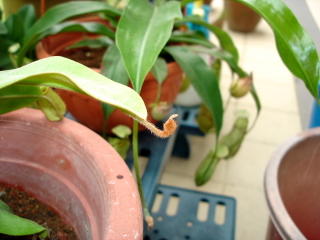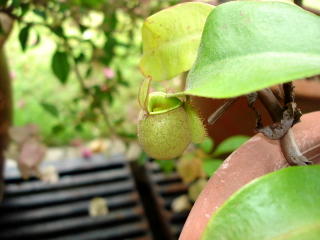The story of Ampy...

From a little brown shoot...

Springs forth the seed of life...
Slowly does it grow...

To bring death to this world...(for insects that is)

But like all good things...
Well hey there! Looks like 'lil Ampy's back! What you see here traces the foramation of a typical pitcher of Ampy's. Nifty, is it not? Don't be fooled though, each of these pitchers may seem small, but Ampy invests a lot of time and energy into making them. In fact, from the point where Ampy's leaf blade completely unfolds to the time when the pitcher is fully formed, up to a month or so may have gone by. I wasn't kidding when I said that Ampy and its kin were slow growers. Still, when Ampy is happy and starts to pitcher...it sure is a sight to behold. Sure, Ampy isn't as flashy as many of its kin, but Ampy has his/her own brand of charm...though that's another story. It may take years for 'lil Ampy to grow up and produce those clusters of pitchers that Ampys are so famous for.
By now, I'm sure some of you'd be asking...so, how does one care for Ampy? Well, here's my answer. Its actually quite easy...if you proceed to forget everything you've learnt about taking care of plants in general. Now you see, this be the Plant Shop 'o Horrors! Our plants ain't quite so normal, if you get my drift...so here's what you do...
The moment you get your pot of Ampy(or any kin), remove ALL, yes, I mean ALL fertilizer in the soil. There may not be any, but check, especially if Ampy was bought from a shop which, unlike us, didn't know what they were doing. I'm not kidding about the moment thing either. This has to be done right away if Ampy is to have any chance of survival whatsoever. Ampy and some of its more hardy kin may be able to tolerate some of the weaker fertilizers, but they sure won't like it. They'll also stop producing pitchers as well. So remove all that fertilizer!!
Done? Good. Very good. The next thing you've got to take care of is water. Water Ampy right away. You can use tap water just this once, but try not to in future. Also, I know Singapore tap water is okay for this once off use, but if you live anywhere else, you might want to check up on your country's water quality. Set aside a container for water storage. Distilled and reverse osmosis water are what Ampy loves best. Rain water works too, but there MUST NOT be any roof run-off at all. Lastly, if you're not rich or just plain lazy...tap water will work, BUT it must be left to stand overnight at the very least. However, it may cause a mineral build-up in the long run, depending on what kind of soil your Ampy grows in.
Now, about where to let Ampy live...you'll need somewhere with high humidity, lots of sunlight and somewhere where it isn't very hot. If you live in Singapore, you'll have the first for sure, unless you decide to place Ampy in an air-conditioned room, which is a no-no. As for the last two requirements, you'll need to find a bright spot that doesn't get direct sun. A less bright spot will do of course, but Ampy may not be in the mood to produce any pitchers. A hot spot will result in leaf burn and of course, Ampy's slow and painful death.
Just a note about Ampy...Ampy's leaves are its life...even more so than Ampy's roots. Keep them in good condition at all costs! If possible, mist Ampy's leaves once a day, though this is optional. Make sure dust doesn't form a layer on the leaves and keep an eye out for bugs and fungus. My Ampy hasn't had any of these yet, but I've heard of cases which have...so beware.
Now that you've gotten this far, just a few things to keep in mind...Ampy likes damp soil...but not water logged soil. In fact, to be on the safe side, remove any trays on the bottom of Ampy's pot. Also, ensure Ampy is watered at least once a day...Ampy hates drying out.
NEVER, EVER, UNDER the PAIN of DEATH, fertilize Ampy. EVER. Resist the temptation!! Ampy grows slowly and this is normal. This includes feeding Ampy's traps. DON'T. At the very least, most ants should be okay, but flies, roaches, etc are NOT. Be safe, not sorry. As I said earlier, Ampy can tolerate some fertilizers, but as a rule, just don't use any. The sole exception is Superthrive and that's not really a fertilizer.
Also resist the temptation of adding water to Ampy's pitchers, especially tap water. Do so and Ampy's pitchers will die. Fairly quickly too. Ampy can produce its own pitcher fluid.
In case you haven't realised, the best way to keep Ampy happy is to mostly just leave Ampy alone. Just remember to keep Ampy watered, of course. If you're paranoid and want to check how Ampy's doing, look at Ampy's leaves and growing tip. If the leaves are in good condition and the growing tip is fairly stiff, then Ampy's happy...and would love to stay that way. This guide applies to all of Ampy's kin too.
Well, that's it for now, till next time, folks!



 Springs forth the seed of life...
Springs forth the seed of life...





